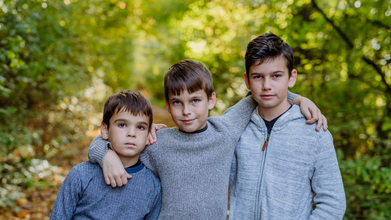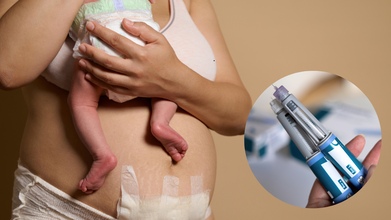- Health Conditions A-Z
- Health & Wellness
- Nutrition
- Fitness
- Health News
- Ayurveda
- Videos
- Medicine A-Z
- Parenting
Breastfeeding Week: Experts Share How Breastfeeding Helps You and Your Child?

Credits: Unsplash
World Breastfeeding Week (WBW), held in the first week of August every year, is a global campaign supported by the World Health Organisation and UNICEF and many Ministries of Health and civil society partners on the protection, promotion and support of breastfeeding. This initiative was started in 1992 to encourage mothers to breastfeed their children and build a support community for new mothers who face any difficulties in breastfeeding.
Why Did We Need An Awareness Week?
Dr Sangeetha Rao TP, consultant obstetrician and gynaecologist who has been practising for the last 13 years says that due to the lack of support from healthcare providers or family, physical challenges like latching difficulties, societal pressures, and misinformation around breastfeeding, many mothers stopped breastfeeding their babies. “Mothers often have the perception that their infant is not satisfied by breast milk alone. Mothers' concerns about lactation and nutrition issues are the most frequently cited reasons for stopping breastfeeding during the first two months,” says Dr Nisha Kapoor, who is the Director and Head of the Department of Obstetrics, Gynaecology and Minimally Invasive Laparoscopic and Robotic Surgery at Marengo Asia Hospitals.Gynaecologist, obstetrician and founder of Baby Soon Fertility and IVF Center, Dr Jyoti Bali with 26 years of experience says, “A reason why some mothers stopped breastfeeding was because of the increased marketing of formula as a convenient solution compared to breastfeeding.”
Experts agree that women undergo physical changes in their bodies during their pregnancy and while breastfeeding too, however, these have been exaggerated. “Breastfeeding can lead to temporary changes in breast size and shape, but these changes are typically normal and revert to baseline after weaning. Perceptions about breastfeeding causing long-term body changes are often unscientific or exaggerated,” says Dr Rao.
These were some of the reasons why women stopped breastfeeding and thus an initiative like World Breastfeeding Week was started. This also aims to highlight the health benefits to the mother and the child on breastfeeding.
Benefits of Breastfeeding on Mother
Breastfeeding is one of the most effective ways to ensure a child's health and survival. As per WHO, moms should initiate breastfeeding within the first hour of birth and continue breastfeeding for the first 6 months.Rao says that for the mother, it helps in faster postpartum recovery, reduces the risk of certain cancers, and can help with postpartum weight loss.
“Breast Feeding helps the mothers to shed their pregnancy weight more quickly because the production of milk requires the burning of calories,” agrees Dr Bali.
Other health benefits to mothers are postpartum healing, bonding with the baby and a decrease in the risk of ovarian cancer, mentions Dr Bali.
Breastfeeding Benefits on Baby
“IgA, IgG, and IgM are among the special proteins and antibodies found in breast milk that are absent from baby formulae. By covering the lining of the baby's developing intestines, these immunoglobulins provide passive immunity, shielding the youngster from potential infections and pathogens,” says Dr Neerja Goel, a senior obstetrician and gynaecologist with 45 years of experience.There are also nutritional values that help a preterm baby in his or her development. “For example, breast milk's higher protein content makes it easier for premature babies to absorb and digest than formula, which encourages better weight gain. Premature babies often have specific nutritional needs due to their early birth. Breast milk provides a tailored balance of proteins, fats, and carbohydrates that support their rapid growth and development. The composition of breast milk adjusts to meet the changing needs of a preterm infant, including higher levels of certain nutrients,” says Dr Goel.
Dr Bali also points out that breast milk contains antibodies, probiotics and DHA and ARA, a kind of fatty acids that are required for brain development. Thus, a baby can benefit a great deal from breastfeeding.
Health Risks When Not Breastfeeding
“Infants, not being breastfed is associated with an increased incidence of infectious morbidity as well as elevated risks of childhood obesity and diabetes. For mothers, failure to breastfeed is associated with an increased incidence of premenopausal breast cancer, ovarian cancer, retained gestational weight gain, Type 2 diabetes, and metabolic syndrome,” points out Dr Ashutosh Sarwa, a health expert in Maternal, Newborn and Child Health & Nutrition at Nutrition International.Poor breastfeeding practices in infancy and early childhood, resulting in malnutrition, contribute to impaired cognitive and social development, poor school performance and reduced productivity in later life.
Sarwa points out that psychological factors like stress, anxiety, postpartum depression, poor latch due to anatomical issues or improper positioning, and other medical conditions are the common reasons for this. “Identification and management of the specific cause, appropriate counselling by a healthcare provider, support (emotional and workplace both) and alternative feeding options,” he says.
Unable To Breastfeed Your Child? Here is What You Can Do
There are now Breastmilk banks which can provide breast milk for your child. Breastmilk banks provide a vital resource for infants who cannot receive breast milk from their mothers, such as preterm or ill babies.Do not be worried about its safety, Dr Rao says that donated milk is screened, pasteurised, and distributed to ensure safety and nutrition.
Are You a Working Mother?
Breastfeeding can be successfully managed for a working mother who must spend lengthy hours away from her child by combining pumping and conserving breast milk.“Purchasing a superior electric breast pump can increase the effectiveness of the procedure. Maintaining a consistent pumping schedule—ideally, every three to four hours—helps keep the milk supply steady. Pumped milk can be refrigerated for up to four days if stored in sterile containers or bags that have been labelled with the date and time. Milk can be frozen and thawed for extended storage,” suggests Dr Goel.
Older, Younger or Middle Child: Does Birth Order Shape Your Personality?

Credits: iStock
Are you a younger sibling in your family and you relate to other younger siblings? Do you feel some of your habits and traits match other younger siblings? Or are you the middle child and you feel that sometimes you are excluded. When you talk about it, other middle children also agree with you. If this is the case with you, then you may be interested to know the Birth Order Theory.
This theory was developed by Alfred Adler in 1964, who focused on the importance of birth order on personality development. In this theory, he says that though children may be born into the same household, their birth order greatly influence their psychological development.
As per Adler's birth order theory, a child could have certain personality traits which are as followed:
- The Oldest Child: more authoritarian, and feels powerful due to high expectations set by the parents
- The Youngest Child: treated like a spoiled baby and cannot rise above the other siblings
- The Middle Child: even tempered, but has trouble fitting in as they have always been sandwiched between the younger and the older siblings
However, for middle child, their characteristics would often get itself a term, called the Middle Child Syndrome.
What Exactly Is A Middle Child Syndrome And What Sets Them Apart From Their Younger And Older Siblings?
Middle child syndrome is the belief that middle children are excluded, ignored, and neglected because of their birth orders.
People often talk about “middle child syndrome,” the idea that the child who is neither the oldest nor the youngest develops a very particular personality. While some of this comes from family dynamics rather than science, many families do notice certain patterns.
Personality Traits
Middle children sometimes feel overshadowed by their siblings. The oldest is often seen as responsible and strong-willed, while the youngest gets extra attention for simply being the baby of the family. The middle child may end up somewhere in the middle of all this, which can make them quieter, more even tempered, and sometimes unsure of where they fit in.
Family Relationships
When it comes to parents, middle children might feel that they do not get the same level of attention as their siblings. The older child usually carries more responsibility, and the younger child often gets extra care and protection. The middle child may feel they slip through the cracks and receive less one-on-one time with their parents.
Sibling Rivalry
Feeling unseen can spark a sense of competition. Many middle children find themselves competing for attention from both parents and siblings. At the same time, they often become the peacemaker of the family simply because they are used to being in the middle of everything.
Feeling Left Out of Favoritism
When parents unintentionally favor the oldest for their achievements or the youngest for their sweetness, the middle child may feel they are no one’s first pick. They are not the trailblazer or the baby, and this can shape how they see their place in the family.
Carrying These Feelings Into Adulthood
Some people believe that these early experiences can follow middle children into adulthood. If a middle child grew up feeling overlooked, they might struggle with co dependency or constantly try to keep the peace in relationships. They may also find it difficult to believe they can be someone’s closest friend or favorite person.
Their personalities often seem muted when it is compared to the other siblings, this is because they have always blended into the background. These patterns can show up at work, in friendships, and in romantic relationships.
What Research Actually Shows
Although middle child syndrome is talked about a lot, scientific research has not clearly confirmed it. There have been studies that show some truth to the theories, while others deny. Some research suggests that middle children do feel less close to their parents or are less likely to turn to their parents when they are going through stressful times in their lives. A 2019 study showed that middle children were less likely to feel comfortable talking to their parents on topics like sex education. Though it is important to note that this is a broad topic to begin with, and could have cultural variations.
Other studies have suggested they might be less family oriented or more prone to certain perfectionistic traits. But these findings are not consistent across research. In fact, a number of large studies show no strong link between birth order and major personality traits such as extraversion, emotional stability, or agreeableness.
Some studies even contradict each other entirely. For instance, one study suggested middle children might have a higher risk of depression, while another found that oldest children were more likely to experience mental health issues.
So Does Middle Child Syndrome Exist?
With so many conflicting findings, scientists cannot say for sure. Many experts believe that personality is shaped by a mix of family environment, parenting styles, cultural background, and individual temperament. Birth order may play a small role, but it is unlikely to be the determining factor.
In short, middle child syndrome is more of a popular idea than a proven scientific fact. Each child’s experience is unique, and many different influences shape who we become.
More New Moms Turning to Ozempic After Birth, But Experts Are Worried

Credits: iStock
Danish researchers were studying the use of medicines on women during and after pregnancy. What they realized is that number of women consuming Ozempic and Wegovy after childbirth has increased. As per their observation, in 2018, less than 5 prescriptions for every 10,000 women post six months of their childbirth were there. However, this number increased to 34 in mid-2022, and by mid-2024, there were 173 prescriptions.
That comes close to 2 percent of all postpartum women. Most of these women were in their 30s, had more than one child, and while many were overweight, they did not have diabetes. They also had no previous history of using GLP-1 medications.
This spike surprised researchers because the postpartum phase is usually a time when the body naturally sheds some pregnancy weight and undergoes major hormonal changes. “In a period characterized by natural weight loss and marked hormonal change, this was unexpected,” said Mette Bliddal, a pharmacologist at the University of Southern Denmark and the study’s first author, as reported by the New York Times. The findings were published in JAMA.
How Was The Study Conducted?
The analysis reviewed 382,277 pregnancies in Denmark from early 2018 through June 2024. Researchers used national health registries to track every live birth and every prescription filled for GLP-1 drugs during the postpartum period. This made it possible to see the rise in real time.
Although semaglutide, the ingredient in Ozempic and Wegovy, is widely used for weight loss, its safety in the months after childbirth is still unclear. This is a time when many mothers are breastfeeding and adjusting to changing hormone levels, sleep disruptions, and recovery from pregnancy.
What We Know and Don’t Know About Breastfeeding Safety
Right now, evidence around the safety of GLP-1 drugs for breastfeeding mothers is very limited. While semaglutide has not been detected in measurable amounts in breast milk and no immediate negative effects have been seen in infants, researchers caution that long-term effects on a baby’s metabolism, growth, or pancreas remain unknown.
Major medical groups are also hesitant to give a firm recommendation. The American College of Obstetricians and Gynecologists has not released guidelines because the drugs are too new and the data isn’t strong enough. First Exposure, a Canadian research network that evaluates drug safety in pregnancy and breastfeeding, advises against using these medications while breastfeeding. They also recommend stopping them one to two months before trying to conceive.
Experts say the caution comes from the lack of solid research. GLP-1 drugs are large molecules that usually do not transfer easily into breast milk and would likely break down in a baby’s stomach. Still, the uncertainty is significant enough that researchers prefer mothers avoid them during breastfeeding.
Why Researchers Are Concerned
Another concern is that these appetite-suppressing medications could affect milk production, nutrient content, or even leave mothers dehydrated. Dr. Bliddal noted that the postpartum period is a time when “the body is working hard to regain its balance.” Without knowing how weight loss drugs interact with these processes, many specialists believe it is safer to avoid them until more is known.
Even small changes in breast milk composition could matter for infant development. Since there is no clear data on how GLP-1 drugs might alter fat content or nutrients in breast milk, researchers urge caution.
Vanessa Hudgens Becomes Mother Again At 36; Is Late Pregnancy Safe For Women?

Credits: Instagram
Vanessa Hudgens at the age of 36 is a mother again. She welcomed her second baby with husband Cole Tucker. The news was announced on Instagram on Saturday, where she shared a photo of herself lying in a hospital bed, holding Tucker's hand.
She wrote: "Well…. I did it. Had another baby!! What a wild ride labor is. Big shout out to all the moms. It’s truly incredible what our bodies can do ❤️."
This month itself, Catherine Paiz revealed that she was pregnant with her fourth baby at the age of 35.
These news of celebrity pregnancy after 30 spark the spotlight on late motherhood and how safe it really is?
What Does The Data Tell Us On The Trend Of Late Motherhood?
The average age of mothers in the US have continued to rise, a new report released on June 13 by the National Vital Statistic System (NVSS), provides the shift in age trends between 2016 and 2023. The study, conducted by Andrea D. Brown, Ph.D., M.P.H., and her colleagues at the National Center for Health Statistics.
The researchers found a clear increase in the mean age of mothers at the time of their first birth. In 2016, the average age of a first-time mother was 26.6 years. By 2023, this had risen to 27.5 years — nearly a full year’s difference in just seven years.
But the trend isn’t limited to first-time mothers. In Paiz's case, she is having her fourth child at 35.
Is Late Pregnancy Healthy?
The National Institute of Health (NIH), US (2022), 20% of women in the US are now having their first child after the age of 35. While it is the new trend, the NIH doctor Dr Alan Decherney, a fertility expert explains that "As women age, they are still fertile, but their odds of pregnancy are decreased because they are not making as many good eggs that will fertile and divide normally and turn out to be an embryo."
After age 30, a woman's fertility decreases ever year, notes the NIH July 2022 issue. It notes: "The number and quality of her eggs goes down until she reaches menopause."
However, experts do point out that getting pregnant in your 30s need not be a stressful affair at all times. As it is at this age when you experience more stability, and also someone you know who have a personal experience in handling one. Most important, you are more mature at this age, which you may not be in your 20s.
What Must You Keep In Mind If You Plan Pregnancy After 30?
Quit Habits: If you are a smoker, or consume alcohol, this is a good time to leave it.
Reduce Stress: While pregnancy for some can bring stress, try to find activities that help you release it.
Healthy Weight: Ensure that your weight is right, reduce your waist to bring it to a healthy range for a healthy pregnancy.
Food Habits: Stop eating junk and start eating more whole grains.
Exercise: A sedentary lifestyle can impact negatively on the child. You do not have to do HIIT, however, regular easy workouts can make both the pregnancy and delivery easy.
Dr Michelle Y Owens, professor of obstetrics and gynecology and a practicing maternal-fetal medicine specialist at the University of Mississippi Medical Center in Jackson, writes for the American College of Obstetricians and Gynecologists (ACOG) that "the longer your eggs have been around, the more likely they are to produce a pregnancy with a chromosome problem that can lead to a condition like Down syndrome. The risk goes up significantly after 35." However, she says, there is a good news. Now, we have tools to detect and respond to pregnancy complications early.
© 2024 Bennett, Coleman & Company Limited

